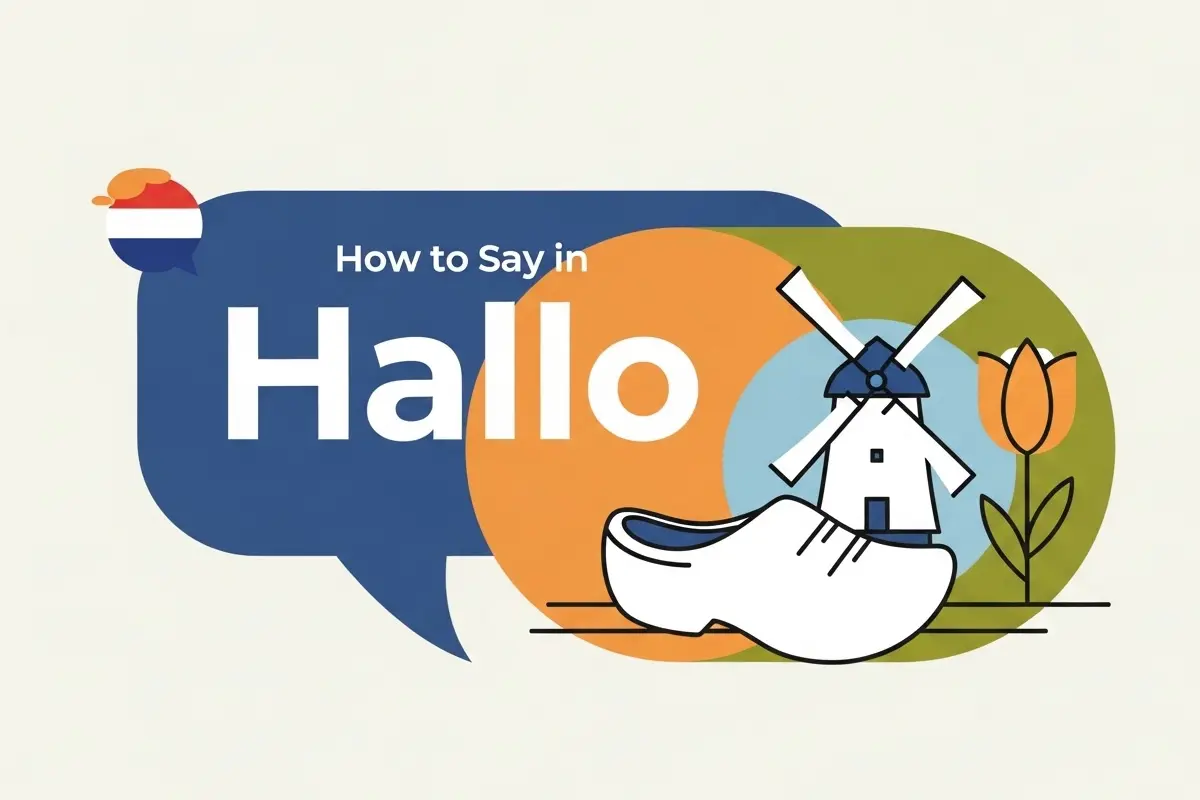
TL;DR
- The most common way to say hello in Dutch is “Hallo” (pronounced hah-loh).
- For specific times of day, say “Goedemorgen” (good morning), “Goedemiddag” (good afternoon), and “Goedenavond” (good evening).
- Informal alternatives include “Hoi” or “Hey.”
- Dutch greetings change slightly depending on formality and region.
- Use tone and gestures (a smile or handshake) to sound more natural.
How Do You Say Hello in Dutch?
The direct answer: the most common word for hello in Dutch is “Hallo.”
It’s universal, easy to use, and works in both formal and informal situations — similar to “hello” in English.
But the Dutch language also has different greetings depending on the time of day, formality, and tone — all of which we’ll explore below.
Knowing these makes you sound more like a local when visiting the Netherlands or speaking with Dutch speakers in Belgium and Suriname.
Common Dutch Greetings by Time of Day
Dutch greetings often include the word “goede” or “goed”, meaning good.
Here’s a quick breakdown of how to greet people politely throughout the day:
| Time of Day | Dutch Greeting | Pronunciation | English Equivalent |
|---|---|---|---|
| Morning | Goedemorgen | hoo-duh-mor-ghun | Good morning |
| Afternoon | Goedemiddag | hoo-duh-mid-dakh | Good afternoon |
| Evening | Goedenavond | hoo-duh-ah-vont | Good evening |
| Night (farewell) | Goedenacht | hoo-duh-nakht | Good night |
| Anytime | Hallo / Hoi | hah-loh / hoy | Hello / Hi |
💡 Note: The g sound in Dutch is guttural, similar to the Scottish “loch.”
If it feels tricky, practice slowly — pronunciation is key to sounding authentic.
Formal vs. Informal Dutch Greetings
The Dutch culture values directness, but greetings still vary by context.
Informal Greetings
Used among friends, family, or peers:
- Hoi! – Hi!
- Hey! – Casual and youthful.
- Hallo! – Neutral and friendly.
Formal Greetings
Used with strangers, colleagues, or in business:
- Goedemorgen / Goedemiddag / Goedenavond – Time-appropriate hellos.
- Dag – Literally “day,” used as a polite hello or goodbye.
- Hoe gaat het met u? – “How are you?” (formal).
When meeting new people or during introductions, a handshake and clear “Goedemiddag” are typical.
Once the relationship becomes casual, Hoi or Hallo are perfectly fine.
Regional and Cultural Greeting Customs
Dutch greetings reflect both tradition and modern friendliness.
According to the Dutch Government’s Cultural Etiquette Guidelines, formality depends on setting and tone, not strict hierarchy.
The Netherlands
- In cities like Amsterdam or Rotterdam, people often greet with a casual “Hoi” or “Hey.”
- In smaller towns, a polite “Goedemiddag” or “Dag” feels more natural.
Belgium (Flemish Dutch)
- Flemish speakers in Belgium often use “Dag” or “Hallo.”
- The tone is warmer and slightly more melodic.
Suriname and Caribbean Dutch
- Greetings may mix Dutch with local expressions or English, like “Hey man!” or “Goedemorgen!” in relaxed tone.
How to Respond to Hello in Dutch
Here’s how to reply when someone greets you in Dutch — keep it simple and natural.
| Someone Says | You Can Reply | Meaning |
|---|---|---|
| Hallo! | Hallo! / Hoi! | Hello! / Hi! |
| Goedemorgen! | Goedemorgen! | Good morning! |
| Goedemiddag! | Goedemiddag! | Good afternoon! |
| Goedenavond! | Goedenavond! | Good evening! |
| Hoe gaat het? | Goed, dank je! En met jou? | I’m good, thanks! And you? |
✅ Quick tip: “Dank je” is informal; say “Dank u” in formal contexts.
For more ways to express gratitude, see our post on Thank You in Dutch Language.
Quick Pronunciation Tips for Beginners
Learning Dutch pronunciation takes practice — especially the famous g and r sounds.
Here are tips to help your hello in Dutch sound natural:
- Soft g – Try a throaty “kh” sound from your throat.
- Roll your r slightly – Especially in “morgen” or “middag.”
- Keep vowels short and crisp – Dutch rhythm is tight and even.
- Smile when saying “Hoi” or “Hallo” – Tone conveys friendliness.
- Listen to natives – Watch Dutch news or YouTube channels for real examples.
If you’d like to practice interactively, try Avatalks’ 3D Dutch Pronunciation Trainer, where our avatars pronounce each greeting clearly and visually sync their speech.
Common Greeting Scenarios in Dutch
Here’s how greetings look in everyday Dutch life:
At Work
“Goedemorgen, iedereen!” – Good morning, everyone!
“Dag meneer Janssen!” – Good day, Mr. Janssen!
Among Friends
“Hoi! Hoe gaat het?” – Hi! How’s it going?
“Alles goed?” – Everything good?
In Shops or Cafés
“Goedemiddag!” – Good afternoon!
“Dank je wel, fijne dag nog!” – Thank you, have a nice day!
These interactions blend friendliness with subtle formality, a hallmark of Dutch communication culture.
FAQ: How to Say Hello in Dutch
Q: What is the most common way to say hello in Dutch?
A: “Hallo” is the standard and works in any situation.
Q: Is “Hoi” rude?
A: Not at all! It’s casual and very common among friends.
Q: How do you say hello formally in Dutch?
A: Use “Goedemiddag,” “Goedemorgen,” or “Goedenavond.”
Q: Can I just use “Hey”?
A: Yes, younger Dutch speakers often use “Hey” casually.
Q: What’s the difference between “Dag” and “Hoi”?
A: “Dag” is polite and neutral, while “Hoi” is informal and friendly.
Conclusion
Learning how to say hello in Dutch helps you connect instantly with locals.
Start with “Hallo”, adapt to the time of day with “Goedemorgen” or “Goedenavond”, and don’t hesitate to use “Hoi” among friends.
These greetings reflect the Dutch balance of warmth and practicality — small words that open doors to conversation.
Once you’ve mastered them, check our lessons on How to Say Thank You in Dutch Language and Dutch Alphabet Guide to continue your journey toward natural fluency.